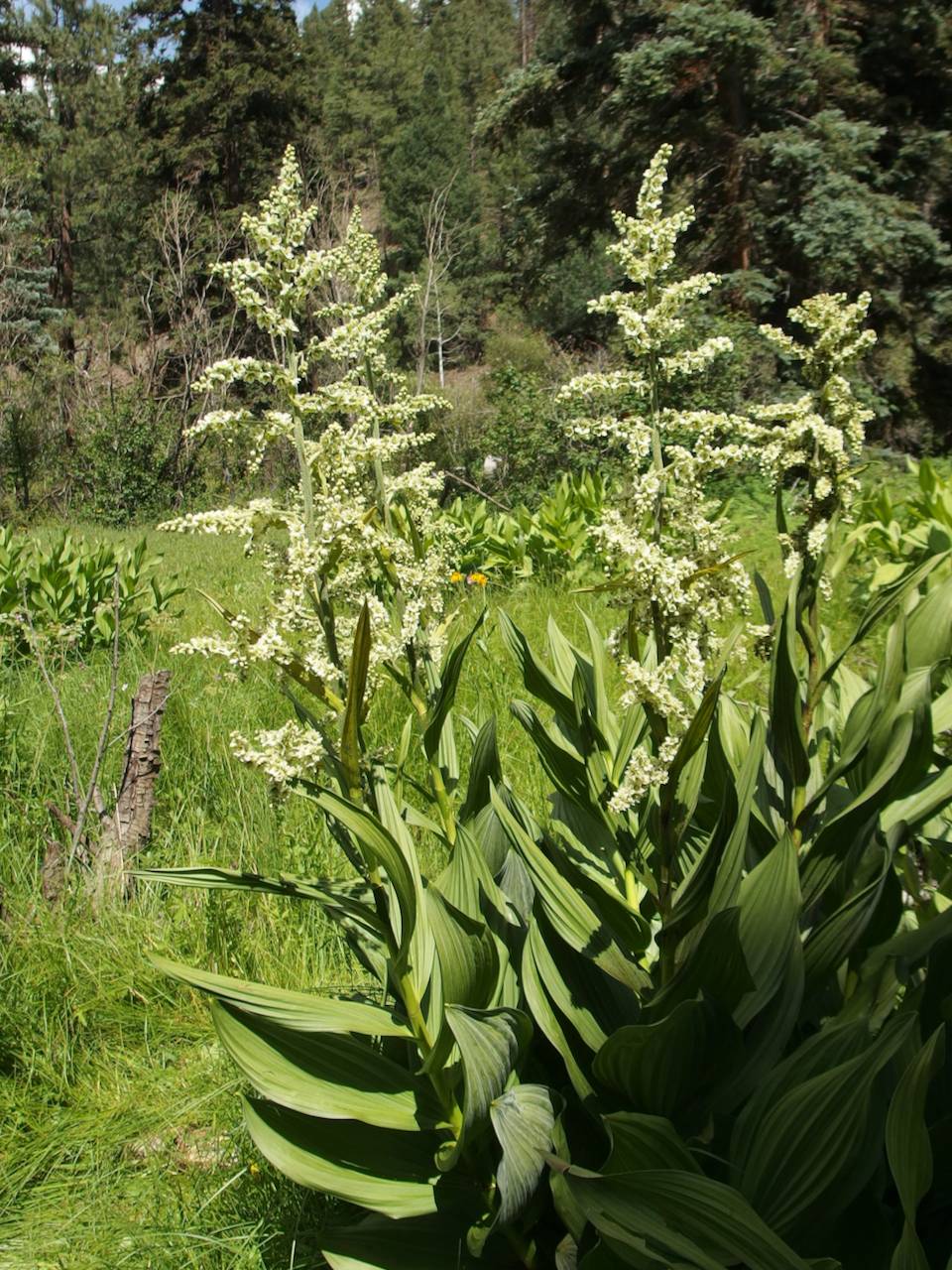Veratrum
|
Family: Melanthiaceae |
Herbs, perennial, from short, thick, vertical rhizomes and swollen basal bulbs; roots contractile, fleshy. Stems erect, simple, hollow, robust, basally thickened, leafy. Leaves alternate, simple, strongly veined, narrowly to broadly orbicular, often plicate, reduced upwards, narrowed into closed, tubular, often overlapping sheaths. Inflorescences compound-racemose or large terminal-paniculate, bracteate, pubescent. Flowers bisexual or some proximal ones staminate; perianth perigynous, rotate to ± campanulate, with hypanthium fused to base of ovary; tepals persistent, 6, spreading to erect, distinct to weakly connate basally, off-white, green, yellow, or purple, petaloid, not clawed, equal to subequal, margins entire or erose-fimbriate; glands 1-2, basal, on adaxial surface, V-shaped over midrib or marginal pair; stamens 6, perigynous; filaments distinct, filiform; anthers persistent, 1-locular with confluent thecae, cordate-reniform, dehiscence apical/valvate; ovary superior or partly inferior, 3-locular; styles 3, erect to divergent, distinct, short; stigmas elongate, extending down inner style surfaces. Fruits capsular, deeply 3-lobed, style beaks persistent, dehiscence septicidal. Seeds ellipsoid to fusiform, flat, broadly winged (± globose with wings reduced to basal ridges in V. fimbriatum). x = 8. The number of Veratrum species depends on the taxonomic treatment of four wide-ranging species complexes, three of which are entirely or mainly Eurasian (V. album, V. nigrum Linnaeus, and V. maackii Regel) and one North American (V. viride) (O. Loesener 1926, 1927, 1928; B. Mathew 1989; J. H. Zimmerman 1958). The Asian species have been variously circumscribed (Chen S. C. and H. Takahashi 2000; H. Kato et al. 1996; T. Nakai 1937, 1937b; N. S. Lee 1985, 1985b). Generic size further depends on inclusion or not of the closely related Melanthium (J. D. Ambrose 1975, 1980; P. Goldblatt 1995; M. N. Tamura 1998; W. B. Zomlefer 1997b), here treated as a separate genus. The medicinal/poisonous properties of Veratrum involve a complex of cerveratrum and jerveratrum alkaloids, some with proven hypotensive properties and others that are highly toxic to humans and livestock (S. M. Kupchan et al. 1961; A. Osol et al. 1960; I. W. Southon and J. Buckingham 1989). Veraloid, a standard mixture of the most hypotensive Veratrum alkaloids, was widely prescribed until late in the nineteenth century, when emetic side effects greatly curtailed its use. The types and concentrations of alkaloids vary with the species, plant part, and season (C. A. Taylor 1956, 1956b). Several Veratrum species are occasionally cultivated surrounded by low-growing plants for their architectural appeal in mesic or bog gardens. Century-old plants grow from the long-lived rhizome-bulb.
Fls polygamous; tep 6, free from the ovary, narrowed at base, not glandular; stamens 6; filaments slender, free or adnate to the perianth at the very base; anthers extrorse, obcordate, with confluent thecae; ovary superior, 3-lobed, each lobe terminated by a short style; capsule ovoid, septicidal, subtended by the withered perianth; seeds large, flat, the small embryo surrounded by a broad wing; tall, coarse, poisonous herbs, perennial from a stout rhizome, with large broad lvs and a terminal panicle of green or purple fls. 30, N. Hemisphere. Gleason, Henry A. & Cronquist, Arthur J. 1991. Manual of vascular plants of northeastern United States and adjacent Canada. lxxv + 910 pp. ©The New York Botanical Garden. All rights reserved. Used by permission. |

